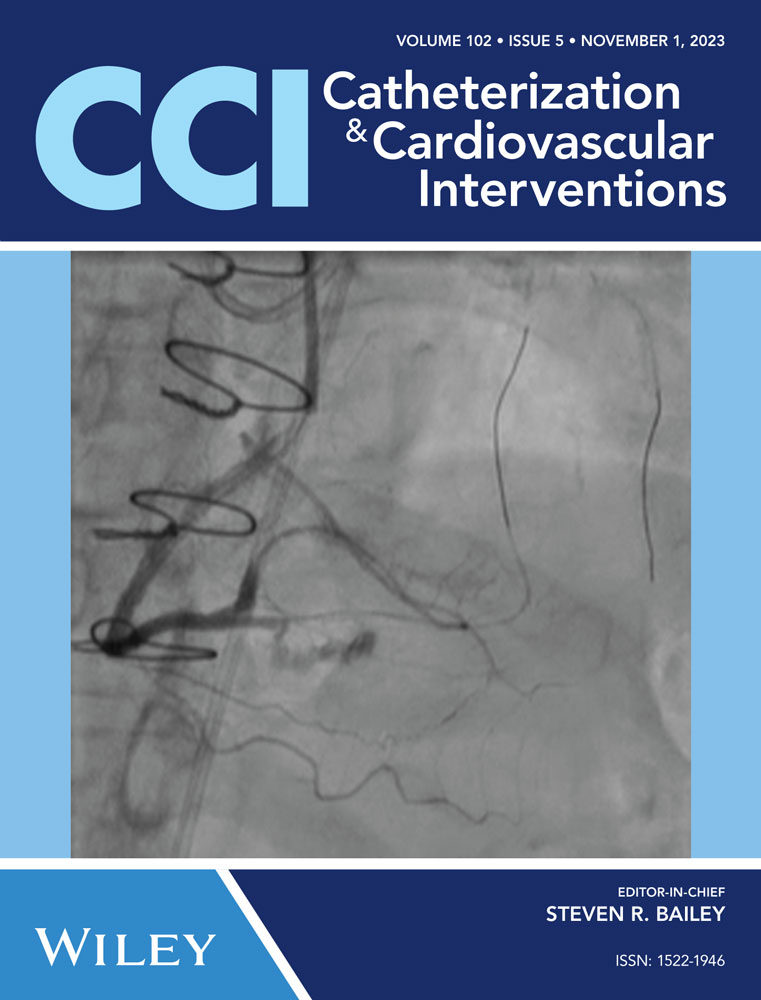Percutaneous ventricular assist device for higher-risk percutaneous coronary intervention in surgically ineligible patients: Indications and outcomes from the OPTIMUM study
Abstract
Background
Indications and outcomes for percutaneous ventricular assist device (pVAD) use in surgically ineligible patients undergoing percutaneous coronary intervention (PCI) remain poorly characterized.
Aims
We sought to describe the use and timing of pVAD and outcome in surgically ineligible patients.
Methods
Among 726 patients enrolled in the prospective OPTIMUM study, clinical and health status outcomes were assessed in patients who underwent pVAD-assisted PCI and those without pVAD.
Results
Compared with patients not receiving pVAD (N = 579), those treated with pVAD (N = 142) more likely had heart failure, lower left ventricular ejection fraction (30.7 ± 13.6 vs. 45.9 ± 15.5, p < 0.01), and higher STS 30-day predicted mortality (4.2 [2.1−8.0] vs. 3.3 [1.7−6.6], p = 0.01) and SYNTAX scores (36.1 ± 12.2, vs. 31.5 ± 12.1, p < 0.01). While the pVAD group had higher in-hospital (5.6% vs. 2.2%, p = 0.046), 30-day (9.0% vs. 4.0%, p = 0.01) and 6-month (20.4% vs. 11.7%, p < 0.01) mortality compared to patients without pVAD, this difference appeared to be largely driven by significantly higher mortality among the 20 (14%) patients with unplanned pVAD use (30% in-hospital mortality with unplanned PVAD vs. 1.6% with planned, p < 0.01; 30-day mortality, 38.1% vs. 4.5%, p < 0.01). The degree of 6-month health status improvement among survivors was similar between groups.
Conclusion
Surgically ineligible patients with pVAD-assisted PCI had more complex baseline characteristics compared with those without pVAD. Higher mortality in the pVAD group appeared to be driven by very poor outcomes by patients with unplanned, rescue pVAD.
CONFLICTS OF INTEREST STATEMENT
Dr. Hirai reports consulting fees from Asahi Intecc, Siemens Healthineers, Zeon Medical and institutional grant support from Asahi Intecc, Abiomed, Siemens Healthineers. Dr Grantham reports speaking fees, honoraria and travel expense reimbursement from Asahi, Boston Scientific, Abbott and Corindus. Consulting fees and advisory board fees for Corindus and Boston Scientific. Institutional research grants from Boston Scientific and Asahi Intecc. Dr. Kandzari reports institutional research grant support from Abbott Vascular, Biotronik, Boston Scientific, Cardiovascular Systems, Inc., Medtronic, Orbus Neich and Teleflex, and personal consulting honoraria from Biotronik, Cardiovascular Systems, Inc., and Medtronic. Dr. Allen reports institutional research grants and proctoring fees from Abbott Vascular, Boston Scientific and Medtronic. Dr. Kirtane reports Institutional funding to Columbia University and/or Cardiovascular Research Foundation from Medtronic, Boston Scientific, Abbott Vascular, Amgen, CSI, Philips, ReCor Medical, Neurotronic, Biotronik, Chiesi, Bolt Medical, Magenta Medical, Canon, SoniVie, Shockwave Medical, and Merck. In addition to research grants, institutional funding includes fees paid to Columbia University and/or Cardiovascular Research Foundation for consulting and/or speaking engagements in which Dr. Kirtane controlled the content. Personal: Consulting from IMDS; Travel Expenses/Meals from Medtronic, Boston Scientific, Abbott Vascular, CSI, Siemens, Philips, ReCor Medical, Chiesi, OpSens, Zoll, and Regeneron. Dr. Yeh reports research grants and consulting fees from Abbott Vascular, Boston Scientific and Medtronic, and consulting fees from Cathworks, Infraredx, Shockwave, and Zoll. Dr. Karmpaliotis reports honoraria from Abbott Vascular and Boston Scientific and equity interest in Nanowear, Soundbite, Traverse Vascular and Saranas. Dr. Salisbury reports consulting and advisory board fees from Medtronic and institutional research grant support from Boston Scientific and Abiomed. The remaining authors report no conflict of interest.
Open Research
DATA AVAILABILITY STATEMENT
The data that support the findings of this study are available on request from the corresponding author. The data are not publicly available due to privacy or ethical restrictions.




